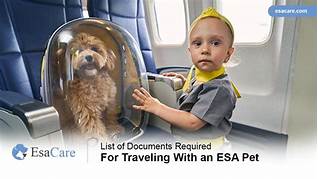What is an ESA Pet?
An ESA, or Emotional Support Animal, is a companion animal that provides emotional support to a person with a disability. ESAs can be any type of animal, but they are most commonly dogs or cats. ESAs are not service animals, which are trained to perform specific tasks for people with disabilities. However, ESAs can provide a variety of benefits to people with disabilities, including reducing stress, anxiety, and depression; improving mood and sleep; and providing companionship and social interaction.

What are the benefits of having an ESA?
There are many benefits to having an ESA, including:
- Reduced stress and anxiety: ESAs can help to reduce stress and anxiety by providing a calming presence and companionship. The simple act of petting an animal can release oxytocin, a hormone that has been shown to have calming effects.
- Improved mood and sleep: ESAs can help to improve mood and sleep by providing a sense of purpose and routine. Caring for an animal can also help to reduce loneliness and isolation.
- Companionship and social interaction: ESAs can provide companionship and social interaction for people who may otherwise be isolated. Taking an ESA for walks or to the park can be a great way to meet new people and make friends.
- Other benefits: ESAs can also provide other benefits, such as improved cardiovascular health, reduced blood pressure, and increased physical activity.
Who can get an ESA?
ESAs are available to people with a variety of disabilities, including:
- Mental health disabilities: ESAs can help people with mental health disabilities, such as anxiety, depression, and post-traumatic stress disorder (PTSD), to manage their symptoms.
- Physical disabilities: ESAs can help people with physical disabilities, such as mobility impairments, chronic pain, and multiple sclerosis, to live more independently.
- Other disabilities: ESAs can also help people with other disabilities, such as cancer, diabetes, and heart disease, to cope with their symptoms.
How do I get an ESA?
To get an ESA, you will need to:
- Get a letter from a mental health professional: You will need to get a letter from a mental health professional, such as a psychiatrist, psychologist, or therapist, stating that you have a disability that would benefit from an ESA.
- Find an ESA: You can find an ESA from a variety of sources, such as animal shelters, rescue organizations, and breeders.
- Train your ESA: Once you have an ESA, you will need to train it to behave properly in public. This includes training your ESA to walk on a leash, not to bark or lunge at other people or animals, and to stay calm in public places.
What are the rules for ESAs?
ESAs are subject to a number of rules. These rules vary from state to state, but generally speaking, ESAs are allowed in most public places, including housing, restaurants, and stores. However, ESAs are not allowed in some places, such as hospitals and schools.
It is important to note that ESAs are not the same as service animals. Service animals are trained to perform specific tasks for people with disabilities, and they are allowed in all public places. ESAs are not trained to perform specific tasks, and they are not allowed in all public places.
Declaration: All article resources on this website, unless otherwise specified or labeled, are collected from online resources. If the content on this website infringes on the legitimate rights and interests of the original author, you can contact this website to delete it.




